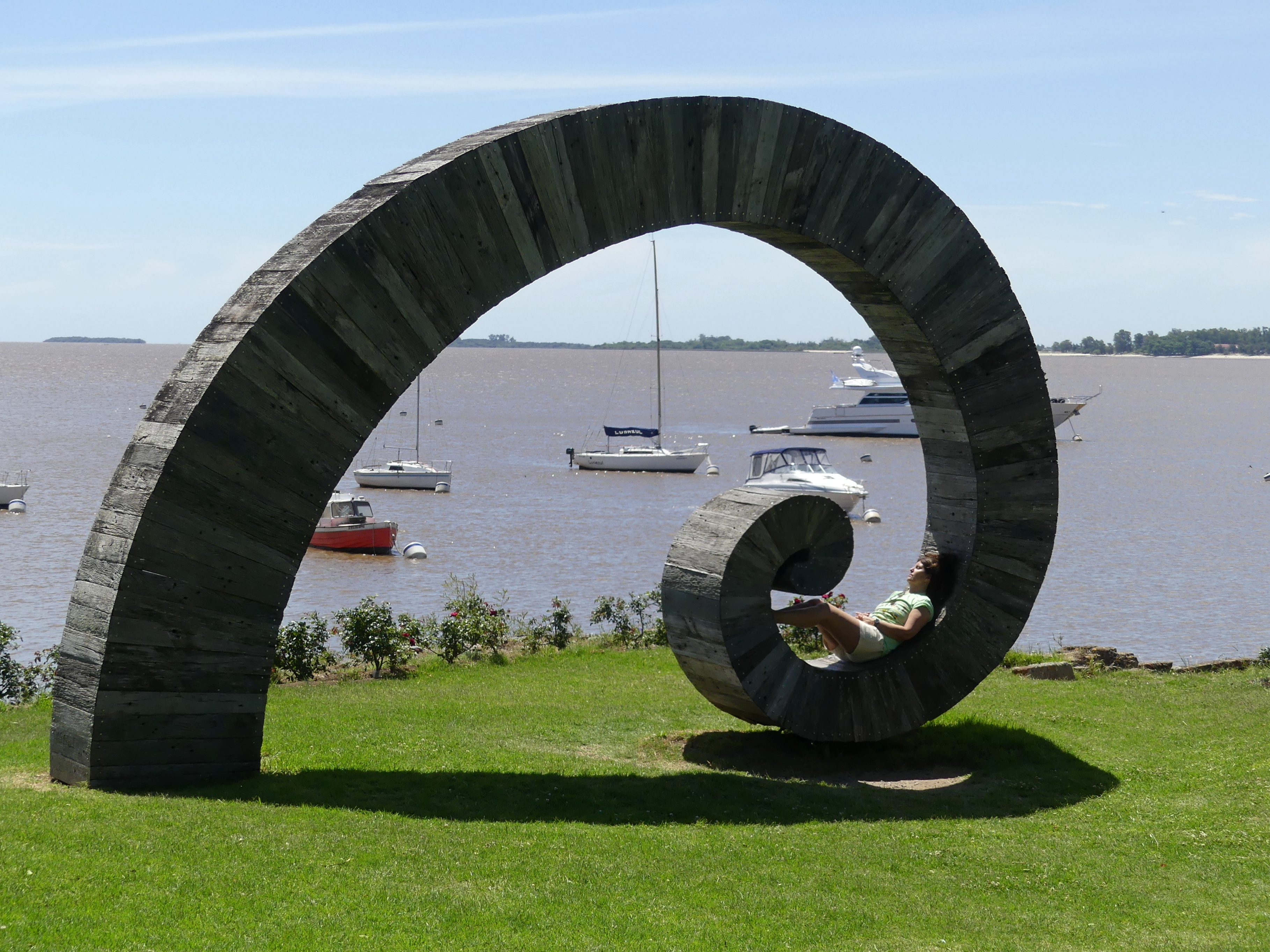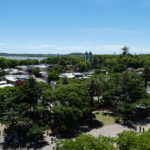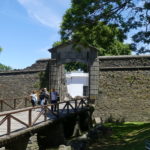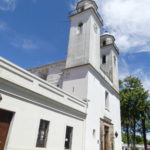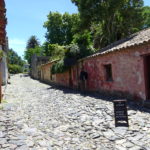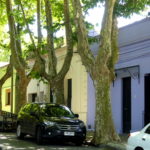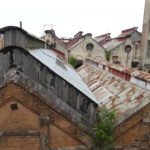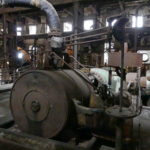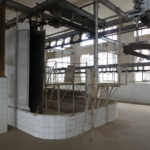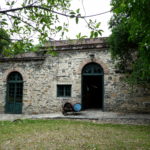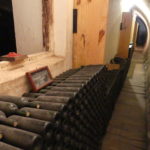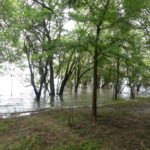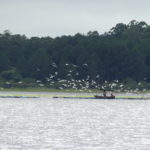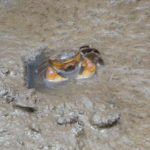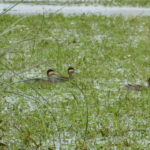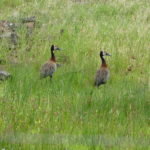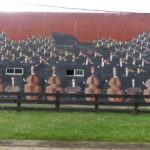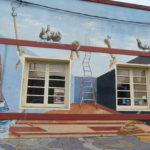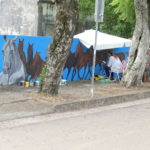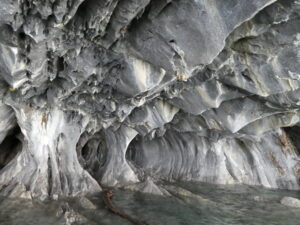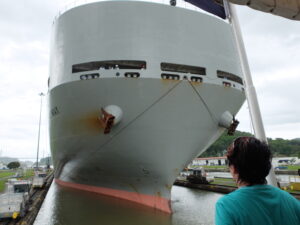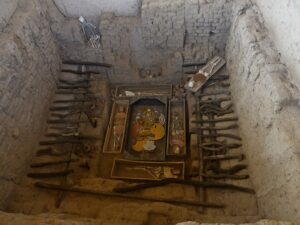Uruguay boasts two very different UNESCO World Heritage sites, both of which we visited during our drive through the west of the country along the Uruguay River – the town of Colonia and a meat processing plant! Along the route to them, we found vineyards to relish. Farther north, there is an amazing expanse of wetlands we visited by boat and by sloshing through spongy grasslands.
COLONIA
First, the 17th century town of Colonia del Sacramento, a battleground won at times by the Spanish, Portuguese and British until the mid-1800s. Afterwards, Colonia became both a major shipping port and a haven for smugglers. As shipping moved away, Colonia fell apart until restored to historic appeal for tourists who take the ferry to and from Buenos Aires.
The view over Colonia, from atop the lighthouse and its spiraling staircase. Its natural harbor is in the background.
The restored gate and walls of the old city of Colonia, once part of the defensive fortification. The town was founded by Manuel Lobo (the wolfman?) across the Rio de la Plate from Buenos Aires, which can often be seen from afar through the misty air of the river.
On the site of the old fortifications of the bastion of Carmen, a spiraling array of bricks shares the delights of the day.
The one-level 18th century homes of Spaniards and Portuguese at Colonia’s Plaza Mayor, some of which are now museums of the old days. We climbed atop the lighthouse tower visible behind. From there, we could see the skyscrapers of Buenos Aires.
The central church of Colonia at Plaza Manuel Lobo, the 18th century administrative center.
Colonia’s much photographed Street of Sighs, which reportedly hosted either brothels or the transport of prisoners. The visiting photographers were all behind us at this time.
Colorful streets surround the old town, so it’s a pleasure to wander around them, even though they’re not the colonial historical buildings.
EL ANGLO PLANT AT FRAY BENTOS
The second UNESCO site memorializes the famous meat-processing plant at Fray Bentos. That began in the mid-1800s with innovative technology to extract essential protein from beef, reducing 32kg of meat to 1 kg of extract, the Liebig process. Think bouillon. Adopting other new technologies over time, it added tinned meat for the British and fresher products. El Anglo failed in 1971, leaving a decaying sprawl of buildings but also a rich legacy in industrial production and technological innovation.
The physical legacy of El Anglo today. Among the fans of the original LEMCO plant’s extract (32 kg reduced to 1kg) were the African explorer Stanley, tender of the wounded Florence Nightingale, Antarctic explorer Scott and the men that Jules Verne sent to the moon. New technologies – canning and refrigeration – later expanded its market. Canning enabled the company to accustom the British to tinned meats (as corned beef), as well as feed the military during the World Wars.
The massive refrigeration equipment, dating back to the 1920s, fed 70 kilometers of piping. This innovation enabled the storage, processing and shipping of various meat products around the world.

This mural in the admin building of El Anglo’s meat plant depicts both a timeline for the evolution of meat processing and the stages of the process – from the cow on the left through the processing to the products, markets and benefits on the right. The very center honors the innovative chemistry from LIebig that started the company.
The central processing hall for the slaughter of animals and removal of useful parts via a conveyor system that moved the carcasses from station to station. The workers wore coats as white as the tiles – and kept very busy. 16 million tins of meat were packaged in 1943, with an animal slaughtered every 5 minutes.
ONE OF MANY VINEYARDS
Uruguayan vineyards are not well known, but produce some very drinkable wines at moderate prices. We enjoyed a delightful guided tour of one of the oldest wineries in Uruguay, Los Cerros de San Juan.
Though a company owns the operation now, this was a family winery from the mid-19th century that spanned at least five generations, a proud tradition. It boasted of workers who had spent their whole lives at the farm.
Our wine tasting included cabernet, tannat and chardonnay. They demonstrated how the soil, weather conditions and veteran vines make Uruguay surprisingly quite adept in producing a “magic liquid” rivaling wines of neighboring countries.
Collector bottles of Tannat from the year 2000 line walls in the cellars. Some went back 50 years.
Oak casks from Germany doing their job
ESTEROS DE FARRAPAS
It’s wet, really wet at the Esteros de Farrapos, the huge nature reserve along the Uruguay River, the border with Argentina.
We spent four hours, partly in a boat on water and partly splashing through water on spongy land, looking for some of the hundreds of birds that come here.
Our knowledgable boatman guided us and our farmstay host through a wetlands landscape that we could not experience in any other way.
At one point, we sloshed through a kilometer of grassland up to our calves in water…a terrain that would be hip-deep within a few hours, as winds blew the river over it. Wet and wild!
Silver teal swimming in shallow waters
The Maguari stork we saw was an especially nice find.
All these birds were wonderful to see, but we related most to the white-faced ibis.
We found that we needed to imitate it as we slogged through muddy waters
A pair of white-faced whistling ducks, padding silently away
SAN GREGORIO DE POLANCO
As we turned eastward from the water-soaked coast of the Uruguay River to hook back to Montevideo, we reached San Gregorio de Polanco.
This is a small town at the eastern end of the huge man-made lake Rincon del Bonete. It’s opposite the better known cross-roads town of Paso de Los Toros.
San Gregorio’s distinction is the colorful, artistic and often amusing display of mural art across the town.
Here are some of our “off-the-wall” favorites there.
(Also, for more pictures from Uruguay, CLICK HERE to view the slideshow at the end of the itinerary page.)


